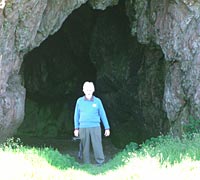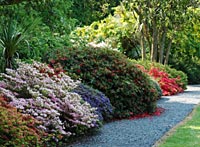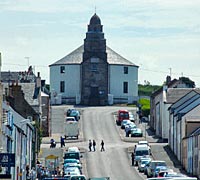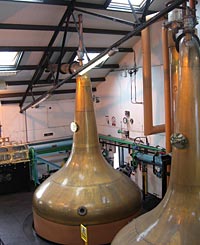Scotland's Islands & Highlands Tour Diary
Day 2 : Campbeltown to Bowmore on
Islay
|
|
The 'Calmac' ferry
approaching Port Askaig, with the Paps of Jura in the
background. |
After an optional tour down
to the bottom of the peninsula and with views over to
Ireland, we traveled up again to take our first ferry, over
to the Isle of Islay, where we visited a distillery before
settling in to our hotel for the next two nights.
Part
of an 11 day/page trip diary - click the links on the right
hand side for the other days in this diary. |
Jeanette and her husband Ken
were on our 2010 Scotland's Islands and Highlands Tour, and
Jeanette kept a detailed day by day diary of the tour.
She has very graciously allowed
it to be re-published here, so as to allow you an unvarnished
view into what the tour was all about.
The text is hers, which I've
respected and not changed apart from a few subheadings and extra paragraph
breaks and some Americanizations of her English spelling (they
are from New Zealand).
I've sourced the pictures and
their captions are also from me, not Jeanette.
You can follow along with her
narration by tracking the tour on this
tour
itinerary page and the linked Google maps.
I hope this will encourage you
to come on our
2018 Scotland's Islands and Highlands Tour.
Day 2 – Tuesday June 15th
2010 – Campbeltown to Bowmore, Isle of Islay
Google Touring Map for the Day
We woke up at 7am to a
beautiful sunny day with clear blue skies. Breakfast at 7:30am
with Janice from San Diego. Ken had Muesli followed by a full
Scottish breakfast (with black pudding) while I had Muesli
followed by scrambled egg, mushrooms and tomatoes. We both
enjoyed a nice cup of hot chocolate, which set us up for the
day, and took a banana for a snack on our journey.
We were
allocated the front seats today, with Ieva and Malcolm, for this
morning's journey so we got some great views as we drove around
the Kintyre peninsular. The bus did not depart until 9:45am so
we had time for a walk in the town after checking out of the
hotel.
Our first stop was 20
minutes away at Southend where we passed another Argyll Arms
hotel. There appears to be many hotels in this region with this
name. There was a large caravan park on the coast at Kiel Shore
but it looked very exposed without any trees for shelter.
|

Ted emerging from the Kiel caves. |
We had
20 minutes to see St Columbus's Footprint in a rock and an old
well beside a very well kept old cemetery. The Kiel caves were
nearby but we trusted Ted when he said you could not see far
into them. We could see the coast of Ireland across the
shimmering sea, very clearly to the South.
On the drive back to Campbeltown, we could see the Isle of Jura where Eric Blair
(better known as George Orwell) lived and wrote his famous book
“1984” in the year 1948. David also told us about the
'Clearances' in the 17th and 18th century when the nobles forced
the crofters off the land creating mass emigrations to countries
as far away as America. They had decided they needed large
tracts of land for keeping sheep, the new 'industry' of the late
1700's.
At 10:50 am we arrived back
in Campbeltown to pick up the remaining 10 passengers, then
drove up the West Coast to Kennacraig. We passed another Argyll
Arms hotel on this coast and were told that it was the first
building in Britain to be bombed/strafed in World War II.
|

The now community owned Achamore Gardens on Gigha. |
We
could see the Isle of Gigha, off this coast, which is the most
southerly and one of the most beautiful of the Hebridean
islands. It now has a population of about 150 people, many of
whom speak Scottish Gaelic, with a mild climate and higher than
average sunshine hours and fertile soils. Gigha has a long
history, having been inhabited continuously since prehistoric
times and is the ancestral home of Clan MacNeill. It fell under
the control of the Norse and the Lords of the Isles before
becoming incorporated into modern Scotland and saw a variety of
conflicts during the medieval period.
The population of Gigha
peaked at over 700 in the 18th century, but during the 20th
century the island had numerous owners, which caused various
problems in developing the island. By the beginning of the 21st
century resident numbers had fallen to only 98. However a
"community buy-out" in 2002 (for £4 million) has transformed the
island, which now has a growing population and a variety of new
commercial activities to complement farming and tourism.
We arrived at Kennacraig at
12:15pm and had to wait on the bus for David and Jay to get our
tickets to cross in the ferry to the Isle of Islay (pronounced
Ila). We watched all the cars go onboard and a few large trucks,
including a Shell tanker. Eventually they came back and we were
able to drive onto the ferry with only room left behind us for
one last truck.
There was a group of 6 Europeans (may have been
Germans) whose mini van was not booked on the ferry and there
was no room for them. As they were only going over for 1 night,
David offered them seats on our bus to take them to Bowmore on
the island. They are hoping their driver will get the van onto
the later 6pm sailing.
There was plenty of room in
the ship's lounges and on the outer decks. There was a cafeteria
selling lunches and a bar selling soft drinks, coffees, teas and
alcoholic drinks. We settled down in the forward lounge for the
2 hour journey when the ship left the port on schedule at 1pm.
It was fascinating watching the bow of the ship be lowered to
close off the entrance to the vehicle deck.
Like all ships we
have ever been on, one of the crew was busy painting the winches
in the front area of the ship. For the journey down the loch it
was calm and sunny but the wind was cool so we stayed inside,
taking turns to go up on deck to take photos from time to time.
Ken settled down for a sleep using my lap as a pillow while I
did some Sudoku. It was a very calm crossing to Port Askaig
where we arrived at 2:55pm and were about the 4th vehicle off
the ship.
|

The unusual round church at the top of Bowmore's
main street. It was apparently built round so the
devil couldn't hide in the corners. |
We climbed a steep hill from
the port on our way to our overnight hotels in Bowmore, the
capital of the Queen of the Isles (as Islay is known). There was
a lot more cloud here and a sprinkle of rain on the windscreen.
On our way, David gave us a very full description on how whisky
is made. There are 9 distilleries on the island making this the
main industry next to tourism for the 3000 population. Bird
watching is also very popular here. This island used to be the
headquarters for the Lords of the Isles. It is quite a hilly
island with lots of sheep farms.
We arrived in Bowmore about
3:20pm and stopped at the Bowmore distillery for a tasting and
tour before going to our 3 hotels. We first watched a DVD about
the distillery while tasting a dram of whisky, but Ken and I
passed ours onto Janice. Whisky has been produced here
continuously since 1779, and illegally before that from 1776. It
was owned by the Morrison family from 1963 to 1994 but is now
owned by a Japanese firm. It is one of the 10 oldest
distilleries in Scotland.
After the DVD, we walked
into the 3 level Malt Barn which was empty due to the extreme
shortage of water on the island. They usually have to close down
in the summer but this year they have closed the processing
plant a number of weeks earlier than usual. The barley is first
steeped in water and then spread out on the malting floor to
germinate. It is manually turned every 4 hours, day and night,
to prevent the build up of heat by tossing the barley into the
air with wooden shovels. During this process enzymes are
activated which convert the starch into sugar when mashing takes
place. After 6 to 7 days of germination the barley, now called
green malt, goes to the kiln for drying. This halts the
germination. The heat is kept below 70C (158F) so that the
enzymes are not destroyed. Peat is added to the fire to impart
flavour from the smoke.
We went upstairs to the 2nd
floor to enter the kiln. We could smell the peat in the kiln
even though it had not been used for 3 weeks. One special
benefit of the malting process being closed was our ability to
get right into the kiln. The 1.5 floors of germinating malt,
when loaded into the kiln, can weigh up to 21 tons. It sits on
fine mesh for 15 hours to allow the smoke from the fire below to
permeate the grains. They feed the fire with peat, which is very
salty and seaweedy, twice a week from nearby peat farms. They
use a heat exchange to take heat from the kiln to the cooler
areas of the buildings and to heat the community swimming pool
nearby. The peat content of their whisky is about 20ppm (parts
per million) which is about average. It can go up to over
100ppm, and down to zero.
We had a good look at the
mill and saw examples of the grain in its different stages from
barley to malt to grist. The dried malt is ground into a coarse
flour or grist, which is mixed with hot water in the mash tun, 8
tons of grist per load. The water is added in 3 stages and gets
hotter at each stage, starting around 67C (153F) and rising to
almost boiling point. The quality of the pure Scottish water is
important to the final flavour of the whisky. The mash is
stirred, helping to convert the starches to sugar. This sweet
sugary liquid is known as wort. The spent grains - the draff -
is processed into cattle feed for the local farmers.
The wort is cooled to 20C
(68F) and pumped into 6 Oregon Pine washbacks (each one named
after a previous distillery owner), where 100 kg (220 lbs) yeast
is added and fermentation begins. The living yeast feeds on the
sugars, producing alcohol and small quantities of other
compounds known as congeners, which contribute to the flavour of
the whisky. Carbon dioxide is also produced and the wash froths
violently. Revolving switchers cut the head to prevent it
overflowing. After about 2 days the fermentation dies down and
the wash now contains 6-8% alcohol by volume. One washback can
hold 40,000 litres (10,567 gallons) which takes 5 hours to fill.
It takes 40 hours to ferment.
|

Two of the stills at Bowmore Distillery, with a
spirit safe in the back left. |
In distillation, the still
is heated to just below the boiling point of water and the
alcohol and other compounds vaporize and pass over the neck of
the still into either a condenser or a worm - a large copper
coil immersed in cold running water where the vapour is
condensed into a liquid. In some mysterious way the shape of the
pot still affects the character of the individual malt whisky,
and each distillery keeps its stills exactly the same over the
years. The wash is distilled twice - first in the wash still, to
separate the alcohol from the water, yeast and residue called
pot ale - the solids of which are also saved for use in animal
feeds.
The distillate from the wash
still, known as low wines, and containing about 20% alcohol by
volume, then goes to the spirit still for the second
distillation. The more volatile compounds which distil off
first, the foreshots, and the final runnings called feints where
more oily compounds are vaporized, are both channelled off to be
redistilled when mixed with the low wines in the next batch.
Only the pure centre cut, or heart of the run, which is about
68% alcohol by volume is collected in the spirit receiver.
40,000 litres (10,567 gallons) of wash becomes 4,800 litres
(1,268 gallons) of spirit. All the distillates pass through the
spirit safe - whose locks were traditionally controlled by the
Customs & Excise. The Stillman uses all his years of experience
to test and judge the various distillates without being able to
come into physical contact with the spirit. The newly distilled,
colourless, fiery spirit reduced to maturing strength, 63%
alcohol by volume, is filled into oak casks which may have
previously contained claret, bourbon or sherry, and the
maturation process begins.
The ‘famous’ (at least
according to Bowmore) Bowmore No. 1 vaults is where some of
their whiskies spend their long lives resting quietly in the
cool, dark, damp cellars below sea level, oblivious to the waves
thrashing the vault's sea-facing wall (although Bowmore say that
the sea air that infuses the vault contributes to the style of
the whisky so produced). There are 22,000 casks in the vault
now, some dating back to 1957. Queen Elizabeth II came here in
2002 when she decided to have her 1957 cask bottled into 640
bottles.
At 5pm we boarded the coach
again for the short drive to the Bowmore hotel, our home for the
next 2 nights. What a difference to the lovely Argyll Arms hotel
in Campbeltown. Here we had a very small bedroom with single
(very narrow) beds. A wardrobe that was just a hole in the wall
and very shallow, not even deep enough to take a coat hanger
without turning it to the side. It had an exceptionally small
bathroom, smaller than any ship's bathroom, with the tiniest
hand basin. The only good factor was that the shower was normal
size with good water pressure. Two nights here will not be any
joy. I spoke to the bar manager (there is no reception desk) and
he said he would organize for the beds to be 'clipped' together
in the morning. This never happened.
About 6pm we went for a walk
in the tiny town to find somewhere to eat for dinner. We tried
the Harbour Inn where some of our party were staying. They
appeared to have a very good seafood menu but the dining room
was fully booked.We met an Australian couple who had flown from
Glasgow to Bowmore today and they were intending to visit as
many distilleries as they could.
We walked all around the
streets, past the High School then tried the co-op to see if
they had any hot food. They were sold out so we decided to try
the Taj Mahal Tandoori restaurant. I ordered pan fried fish and
chips (not very Indian) as the fish was salmon. Ken ordered Duck
Tiki Masala which is supposed to be mild. He said the sauce was
nice but it was not what he had expected. My salmon was
delicious so I shared some with Ken and he had half of my chips
and peas so we both had a reasonable meal. Unfortunately when we
came to pay they told us they did not have a working visa
machine even though they had a notice in the window that said
they accepted visa. We just had enough cash to pay (£21.90) but
are now nearly out of cash.
We walked to the Harbour Inn to book
dinner for tomorrow night but they told us they were fully
booked again. We met Jay on our way back to our hotel and he was
surprised at the lack of food places in this town. The only food
shop was the co-op.
When we got back to our hotel we saw the
manager who gave us a code to access their wi-fi network. At
last we are on the Internet again which is a slight compensation
for the ridiculously small bedroom. I had a nice chat with David
Rowell on Skype. He had to pay for Internet access at the
Harbour Inn so we were better off here in that regard.
I phoned
Mum in NZ, via Skype, and had a nice long chat, the first for 4
days. Lights out just after midnight.
Read more in the rest of
Jeanette's Diary
See the links to each day
of the eleven day tour/trip diary at the top
right of this page.
|
If so, please donate to keep the website free and fund the addition of more articles like this. Any help is most appreciated - simply click below to securely send a contribution through a credit card and Paypal.
|
Originally published
7 Jan 2011, last update
30 May 2021
You may freely reproduce or distribute this article for noncommercial purposes as long as you give credit to me as original writer.
|

